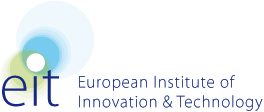EIT-KICS
About European Institute of Innovation and Technology (EIT)

The EIT is a body of the European Union established in March 2008. Their mission is to increase European sustainable growth and competitiveness by reinforcing the innovation capacity of the EU.
This translates into developing a new generation of innovators and entrepreneurs. To do so, the EIT has created integrated structures (Knowledge and Innovation Communities), which link the higher education, research and business sectors to one another thereby boosting innovation and entrepreneurship. The KICs focus on priority topics with high societal impact, currently: Climate change mitigation (Climate-KIC), Information and Communication Technologies (EIT ICT Labs), Sustainable Energies (KIC InnoEnergy).
What are Knowledge and Innovation Communities (KICs)?
The KIC is the independent but operational part of the EIT, which puts the innovation web into practise.
KICs are legally and financially structured entities of internationally distributed but thematically convergent partners. These partners involve key actors from the three sides of the knowledge triangle: research, higher education, and innovation-entrepreneurship-business. KICs build innovative webs of excellence across the knowledge triangle with the intention of addressing key societal challenges. KICs must address a long-term horizon of 7 to 15 years, but with short-, mid- and long terms objectives that follow the mission of the KIC.
Who can be part of a KIC?
KICs bring together different people working together across the innovation web. Key actors include: businesses (including SMEs); entrepreneurs; research and technology organisations; higher education institutions; investment communities (private investors and venture capital); research funders, including charities and foundations; local, regional and national governments.
According to the EIT Regulation, the activity of a KIC must involve at least three independent partner organisations. The partners must be established in at least three different EU Member States and must include at least one higher education partner and one private company. With the intention of strengthening the innovation capacity, KICs may also include non-Member State partners.
The first three Knowledge and Innovation Communities (KICs)
The EIT designated its three first KICs in December 2009:
